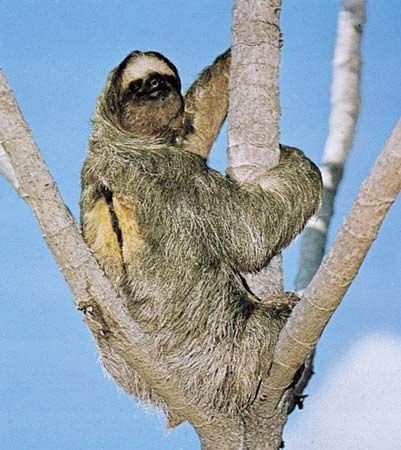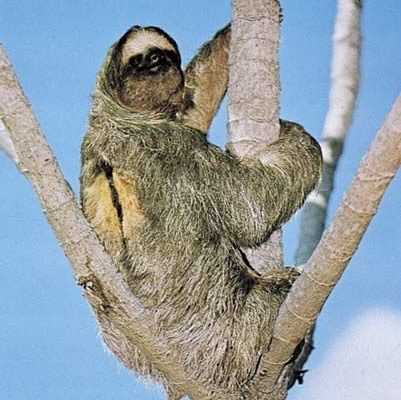
So, how did the three-toed sloth get to where it is today? Let’s dive into its history—a journey that spans countless generations, incredible environmental shifts, and remarkable resilience. Understanding their past not only helps us appreciate these charming creatures but also sheds light on the ecosystems they inhabit today.
Understanding the Three-Toed Sloth
The three-toed sloth, known scientifically as *Bradypus*, is one of the most recognized members of the sloth family. Unlike its two-toed counterpart, the three-toed sloth has a unique set of adaptations that allow it to thrive in its leafy environment. They have long limbs, a slow metabolism, and a diet primarily consisting of leaves. These traits are not just quirks; they’re crucial for survival in the dense jungles of Central and South America.
You might be wondering, why the focus on three toes? Well, the name itself comes from the distinct number of claws on their forelimbs. Each claw is adapted for gripping branches, allowing sloths to hang upside down while they munch on their favorite foliage. It’s a bit like using a specialized tool that’s perfect for the job, only in this case, the tool is built right into their bodies!
The Origins of Sloths: A Glimpse into the Past
To truly appreciate the three-toed sloth, we need to rewind the clock. Sloths have a rich evolutionary history that dates back about 60 million years. Believe it or not, their ancestors were much larger and roamed in diverse environments. The early relatives of sloths belonged to a group known as the Xenarthrans, which also includes anteaters and armadillos.
These ancient sloths were land-dwelling creatures, grazing on grass and foliage. Some were as big as a modern-day elephant! Imagine a giant sloth lumbering through a prehistoric landscape, far different from the tree-dwelling sloths we see today. Over time, changes in climate and vegetation pushed them to adapt, leading them to the tree-dwelling lifestyle we recognize now.
Adaptations That Define the Three-Toed Sloth
One of the most remarkable aspects of the three-toed sloth is its collection of adaptations. Their slow metabolism is a key feature allowing them to survive on a low-energy diet consisting mainly of leaves. This leisurely lifestyle means they don’t need to eat large quantities of food, making them perfectly suited to their leafy environment.
You might find it intriguing that sloths have a unique digestive system. They house specialized bacteria in their stomachs to break down tough plant materials. It takes sloths a whopping month to digest their food fully! Talk about patience. Because of this slow digestion, sloths spend most of their time hanging around, conserving energy while waiting for their meals to process.
Climate Change and Its Impact on Evolution
Throughout their evolutionary history, climate change has played a significant role in shaping the three-toed sloth. As the climate shifted, so did the types of vegetation available for food. During the Ice Age, many of the larger, prehistoric sloths vanished, likely due to changes in habitats and food sources.
While this may sound grim, the three-toed sloth adapted by evolving into a smaller, tree-dwelling species. This shift allowed them to occupy a different niche within their environment. They became masters of the treetops, utilizing their slow movements to remain hidden from potential predators and conserve energy.
The Role of Three-Toed Sloths in Their Ecosystem
Three-toed sloths are more than just quirky creatures; they play a vital role in their ecosystems. As they move slowly through the trees, they help with seed dispersal. Their diets consist of various leaves and fruits, and when they excrete waste, they help spread seeds throughout the forest.
This, in turn, contributes to biodiversity, allowing various plant species to flourish. Think of sloths as the unintentional gardeners of the rainforest, fostering a rich habitat for countless other species. Their presence helps maintain the balance of their ecosystem, which is essential for many animals and plants alike.
Conservation Status: Protecting Our Sloth Friends
Unfortunately, despite their fascinating history, three-toed sloths face significant threats today. Habitat destruction due to deforestation is one of the biggest challenges they encounter. As humans continue to expand agriculture and urban development, these gentle creatures are losing their homes.
Additionally, climate change poses an ever-growing risk, altering the conditions sloths rely on for survival. Conservation efforts are crucial to protect these enchanting animals and their habitats. Organizations dedicated to wildlife preservation are working tirelessly to create protected areas and raise awareness about the importance of sloths in their ecosystems.
The Future of the Three-Toed Sloth
Looking ahead, the future of the three-toed sloth hangs in the balance. With ongoing conservation efforts and increased awareness of their plight, there’s hope for these delightful creatures. You might be surprised to learn that even small actions can make a difference; supporting sustainable practices can help protect sloth habitats.
Additionally, education about the value of biodiversity and wildlife conservation can inspire individuals to take action. By understanding the evolutionary journey of the three-toed sloth, we can better appreciate their role in nature and work to ensure they continue to thrive in our world.
In conclusion, the evolutionary history of the three-toed sloth is a captivating story of adaptation and survival. From their ancient ancestors to their modern-day existence in the treetops, these creatures have a lot to teach us about resilience and the importance of conservation. Let’s continue to learn, protect, and celebrate these remarkable animals as they slowly navigate the world around them.

